Some DC tourism issues (National Tourism Week: May 7th - May 13th)
One of my earliest blog posts is from February 2005, when I wrote that people in commercial district revitalization should think of themselves as "destination managers," and if we make places that are great "for us," fortunately they are also interesting and attractive to visitors.
-- "Town-City branding or 'We are all destination managers now'"
Bike share. An example is how the city's bike share system is subsidized by visitors who rack up lots of extra fees for using the bikes. This pays a significant proportion of the system's operating costs.
Destination DC is DC's destination marketing organization. Destination DC is the city's "destination marketing organization" (formerly referred to as "convention and visitors bureaus) and it is complemented by EventsDC, which owns and manages sports facilities.
Earlier in the week Destination DC announced that DC had record tourism numbers for last year ("DC draws 20 million domestic tourists in year for 1st time," Associated Press), chalked up in large part to the opening of the new Smithsonian National Museum of African-American History and Culture. From the article:
According to Destination DC, the 20 million visitors was an increase of 700,000 over the previous record for domestic visitation, which was set in 2015. International visitor totals will be released in August.DC definitely has opportunities for improving how it deals with and profits from tourism. This might give us the idea that my criticisms of how DC organizes and delivers its tourism offer are unfounded. They're not.
The Smithsonian's National Museum of African American History and Culture, in the shadow of the Washington Monument, opened in September and has already drawn more than 1 million people. Admission is free, but unlike other Smithsonian institutions, the museum is using timed entry passes to manage the crowds.
Visitors also were drawn to Washington by new and refurbished hotels and, for the first time, Michelin-starred restaurants, Destination DC president Elliott Ferguson said in a statement. By far the highest-profile hotel to open last year was Trump International Hotel on Pennsylvania Avenue, five blocks from the White House, which quickly became a gathering spot for supporters of President Donald Trump.
Michelin released its first travel guide for Washington in October and 11 restaurants in the city earned stars, along with the Inn at Little Washington in the rural town of Washington, Virginia.
I have some basic criticisms:
-- unlike other major US cities, DC doesn't have a real visitor center (it does have an information desk in the Convention Center, but the Convention Center doesn't offer parking, which is a problem for people arriving to the city by car and seeking information)
-- the federal institutions with visitor centers (National Park Service, Smithsonian, Capitol Visitor Center) do not distribute any information not produced by the federal government, so these centers do not provide printed information or guidance on any other city attractions
-- the tourism tax revenue stream needs to be used more systematically to support tourism assets other than the Convention Center
-- the city's "destination marketing organization" needs to support systematically sub-city tourism, especially for Capitol Hill, Dupont Circle, and Georgetown (many other jurisdictions have secondary visitor centers in major destinations within the city)
-- the city ought to have an annual tourism conference -- most states have them (e.g., both the Maryland Tourism and Travel Summit and the VA-1 Tourism Summit are in November) -- to help build the tourism sector beyond the federal institutions
-- Destination DC isn't very good about providing tourism information to visitor centers outside of DC, even though most of those centers report that the primary interest of visitors
-- the federal government should consider the creation of a master visitor center (such activities would be covered by the Visitor Element of the Federal Elements of the DC Comprehensive Land Use Plan)
-- the region should consider developing a set of systematic visitor centers at the region's three airports (two in Virginia and one in Maryland)
-- the transit system could do a better job offering special pricing for tourists -- granted providing such pricing is seen as unfair to residents, who fund the system, on the other hand it should be seen as a transportation demand management initiative
Yes, I understand DestinationDC focuses on filling the Convention Center with events since they have to pay off the bonds that financed its construction. From "Massive anime convention Otakon comes to DC this summer," (WTOP):
The District will host nearly two dozen citywide conventions this year — those that take up multiple hotels and venues — including the city’s first time ever hosting a massive anime convention called Otakon.But other DMOs have similar situations and still manage to have a much broader purview.
DC needs a tourism plan. The best way to deal with this would be to create a Tourism Development and Management Plan as part of the DC Comprehensive Plan, something I suggested c. 2004, based on the experience of Charleston, SC.
It would cover marketing too. I am not a fan of the current program ("I don't get DC's visitor marketing ad campaign at all,") but it is claimed that it is successful.
-- DC Cool in Washington, Washington.org
S
 haring options for lodging. Personally, I don't think airbnb and similar sharing programs are a big issue in the city.
haring options for lodging. Personally, I don't think airbnb and similar sharing programs are a big issue in the city. Mostly, the hotels and hotel workers unions are fighting this battle, because they believe it's an either-or choice, and they don't want to lose any business.
As I argued in the other piece, that's too simplistic a perspective, and the hotel industry isn't the only player that needs to be satisfied. People want access to a variety of lodging types and experiences when they travel, and this is an option that satisfies a certain segment of the market, and likely many of these people wouldn't visit the city otherwise, had this option not been available.
I do think that it's reasonable to put restrictions on how many properties can be listed, they should be licensed and stays taxed, so that these visitors still contribute to the tourism tax revenue stream, and of course, properties that shouldn't be made available through such programs shouldn't ("DC attorney general sues Ginosi for allegedly treating rent-control apartments like ‘hotel rooms’," Washington Post).
City Tourism
The United Nations World Tourism Organization also sponsors a Global Summit on Cities Tourism. The sixth conference will be held in December in Kuala Lumpur, Malaysia.
The first conference resulted in the production of the Global Report on City Tourism. The UNWTO is especially focused on the economic development potential that tourism presents. From the report:
Cities appeal to a broader market, they are easy to reach and they have a lot to offer, this also brings a new spending pattern that can go from those staying in budget hotels to the five star hotel customer, but all have one thing in mind: they want to discover and visit other cities. Cities need to assess their products and understand which of their products offerings appeal to the market.
 The report on City Tourism is part of a series of UNWTO reports, ranging from UNWTO AM Report Vol. 4 'Global Report on Food Tourism and AM Reports Volume 3 'Global Report on LGBT Tourism to AM Report No.5 Global Report on Aviation.
The report on City Tourism is part of a series of UNWTO reports, ranging from UNWTO AM Report Vol. 4 'Global Report on Food Tourism and AM Reports Volume 3 'Global Report on LGBT Tourism to AM Report No.5 Global Report on Aviation.Urban Cultural Tourism
A big thrust in urban tourism for the last 20+ years has been "cultural tourism," which addresses historic architecture and local history. It's touted for many reasons, especially because improving local cultural assets also serves residents.
From "Cultural Visitor Profile" from the National Assembly of State Arts Agencies:
In a nutshell, cultural tourists compared to the average U.S. traveler:
- Spend more: $623 vs. $457
- Are older: 49 vs. 47
- Are more likely to be retired -- 20 percent vs. 16 percent
- Are more likely to have a graduate degree: 21 percent vs. 19 percent
- Use a hotel, motel or B&B -- 62 percent vs. 55 percent
- Are more likely to spend $1,000+/-: 19 percent vs. 12 percent
- Travel longer: 5.2 nights vs. 3.4 nights
- Travel by air: 19 percent vs. 16 percent.
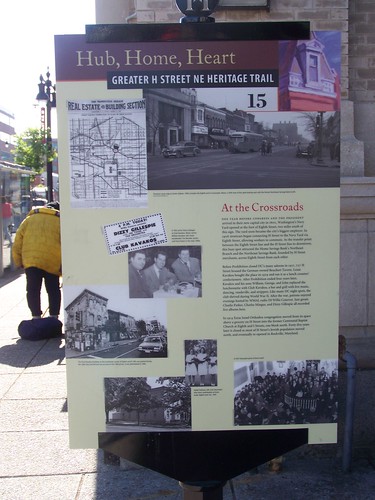 Left: CulturalTourismDC trail sign on H Street NE in Washington, DC.
Left: CulturalTourismDC trail sign on H Street NE in Washington, DC.Because cultural tourists spend more time and money compared to other segments of the tourism market, this is seen as a particularly desirable segment of the market.
DC and tourism planning. DestinationDC is the city's tourism bureau, called a "convention and visitors bureau" in the trade. It mostly focuses on landing big events to be held at the Convention Center.
It doesn't provide systematic support for sub-city tourism initiatives and services, unlike say, Miami ("Why Miami-Dade has more visitor centers than any city in the U.S.," Miami Herald).
While regional tourist centers experience a high demand of information on DC, because DC is the primary visitor destination, for the most part DestinationDC doesn't provide information to those centers (guidebooks and maps) unless they pay for them.
In DC, CulturalTourismDC is the leading organization focused on strengthening local history interpretation. They used to sponsor walking tours across the city in the spring and fall. Now they only do this in the fall.
CTDC's funding has dropped considerably over the years and I argue that the local tourism destination marketing organization, Destination DC, ought to do more focused funding of development activities for cultural destinations.
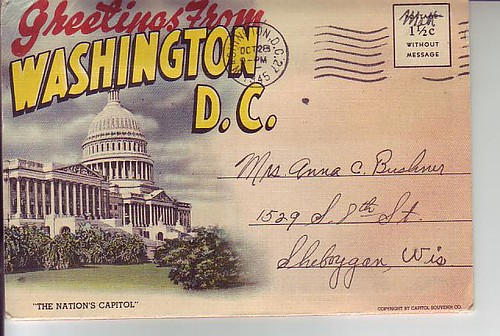 While I hesitate to use the word "unique" in comparing jurisdictions, DC (and Salt Lake City, which is defined in terms of its place as the headquarters of the Mormon Church, or Vatican City and its place as the Holy See) has a unique tourism marketing problem in that it is defined globally as the Federal City, the US National Capital, and this shapes very specifically what visitors want to consume when they come here:
While I hesitate to use the word "unique" in comparing jurisdictions, DC (and Salt Lake City, which is defined in terms of its place as the headquarters of the Mormon Church, or Vatican City and its place as the Holy See) has a unique tourism marketing problem in that it is defined globally as the Federal City, the US National Capital, and this shapes very specifically what visitors want to consume when they come here:- US Capitol
- White House
- Museums on the National Mall, especially the Air and Space Museum, but also the Museums of National History and American History
- the Monuments on the National Mall
- Mount Vernon, George Washington's plantation
- Alexandria and Georgetown as old port towns but mostly as commercial districts with historical references
- maybe the Kennedy Center
(and for certain audiences, the Franciscan Monastery and the Shrine of the Basilica of the Immaculate Conception, both in Brookland).
National "cultural tourism" versus "neighborhood cultural tourism." That doesn't leave much time, space, and interest for visiting "local DC." Note how the souvenir postcard folder pictured above doesn't feature "local" historic landmarks, but landmarks related to the federal city.
One of the problems of neighborhood-based tourism in the city is that while you can walk around attractive neighborhoods and appreciate the architecture, or follow a heritage trail, there are few attractions to visit and the retail and restaurant options are limited.
Fortunately, as the city's population increases, it supports more interesting local businesses and a restaurant scene is developing ("In DC, a Street's Grit Gives Way to Glamour" and "A Trendy Turn in Obama's Town" from the New York Times and "DC's Diverse Cuisine," from the Cooking Channel show "Chuck's Eat the Street").
Eastern Market is one of the few neighborhood attractions of major scale outside of a shopping district, but is more likely visited in association with the out-of-town visitor market associated with people who live here. The National Zoo has a mix of local and out-of-town visitors.
Union Station is called the city's #1 visited place, with more than 20 million visits each year, but the majority of these visits are associated with local transportation (subway and commuter related railroads) and aren't really tourist visits.
Salt Lake City has a similar marketing positioning problem in terms of how it is perceived as the home and headquarters of the Mormon Church and therefore "everything there to see must be related to the Church." That is decidedly not true--and Utah more generally has been very successful at marketing its outdoor activities as part of its tourism offer.
With the failure of the City Museum here in 2004, and my realization that we don't have a "local" art museum devoted to local and regionally relevant art, I have come to realize how problematic it is that we don't have a wide ranging cultural plan and our funding scheme for local attractions is disjoint--we spend a lot of money, but we don't spend it very well.
I can't even count the number of entries I've written on the topic, but here are some:
-- "Town-City branding or 'We are all destination managers now'"
-- "Tourism Marketing and DC"
-- "You (Don't) really like me--DC and its suburbs"
-- "Who ♥ DC? -- More about DC tourism"
-- "Civic Tourism"
-- "Central Library Planning efforts and the City Museum, how about some learning from Augusta, Maine, and Baltimore"
-- "Cultural resources planning in DC: In the land of the blind, the one-eyed man is king"
I have argued that the city should manage itself in terms of heritage and tourism as a cultural landscape, comparable to a "heritage area," whether or not the city aimed to create a formal heritage area or seek federal designation as a national heritage area.
Visitability
The New York Times reported about how the local Convention and Visitors Bureau, NYC & Company, has put a visitor center in Macy's, because the store gets a huge number of tourist visits, more than six million annually. See "Tourist-Hungry New York to Put Visitor Center in Macy's."
I came across some interesting work from Australia (via the Australian National Tourism and Events Excellence Conference website), including how Destination Melbourne is refocusing their work on the elements which make cities great places to visit, which they call "visitability." The concept is based on a presentation to the organization by Rick Antonson, CEO of Tourism Vancouver, and focuses on five elements equally important to residents and visitors:
- Safety
- Access and transport
- A sense of community – no matter where you are from
- Confidence
- Good infrastructure that serves the people
Bad experiences are memorable too...
Destination Melbourne is creating a "visitability framework" to focus their efforts in making Melbourne a "compelling destination" and driving continuous "improvement in services and experiences" offered to residents and visitors.
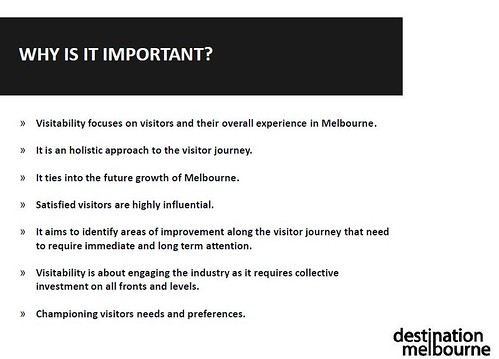
Slide from a presentation by Destination Melbourne at the TEE Conference.
NOTE that in the urban planning world, especially relating to transportation and the built environment--although because of a strong bike helmet requirement, bike sharing has basically failed there, and livability, Melbourne is highly touted and has been picked by The Economist Magazine as the world's most livable city for three years in a row. See "Melbourne ranked world's most liveable city - again" from the Melbourne Age.
So they must be doing something right. Even so, clearly they aren't satisfied with resting on their laurels, and partly this is because when the compare their city to others, "they have no great icons - no Rock, Reef, Opera House, SeaWorld, Disneyland or Giant Pineapple." This motivates them to work harder.
But the visitability concept is applicable to tourism entry points at all levels: sub-local; local; regional; state; and national/international.
Visitor Center policies and case studies
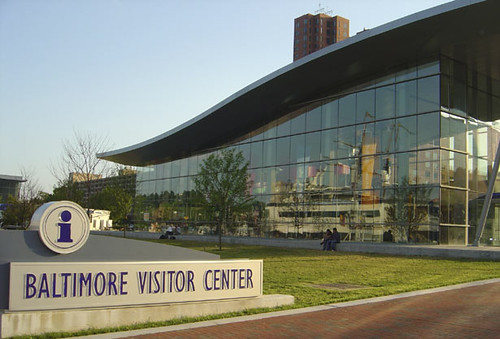 Left: The Inner Harbor is Baltimore's #1 visitor attraction and the Visitor Center is located in a building on the waterfront.
Left: The Inner Harbor is Baltimore's #1 visitor attraction and the Visitor Center is located in a building on the waterfront. Most states have a network of visitors centers, which are typically run by the state tourism agency (which is usually part of the Dept. of Economic Development) in conjunction with local destination marketing organizations.
Cities may have more than one visitors center, a main location definitely, and sometimes subsidiary centers. New York City has main tourist centers and certain business improvement districts, like Chinatown and the Fashion District, run local visitor centers. Pittsburgh has a main center in the Golden Triangle and secondary centers at highly visited attractions such as the Pittsburgh History Center (a great local history museum). Petersburg Virginia has a main visitors center in the city, but they also run a "state" visitors center on I-95, and include some artifacts displays there as well.
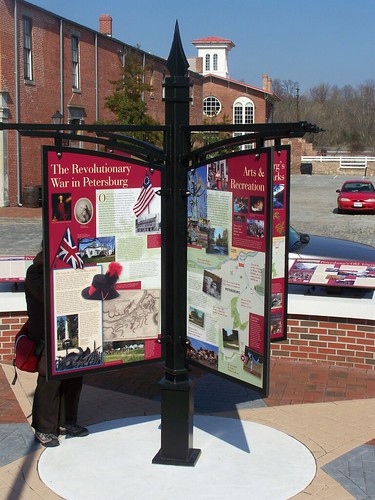 Right: Petersburg has a great set of cultural-historic interpretation signage in the plaza across from their visitor center (which is located in an old railroad station).
Right: Petersburg has a great set of cultural-historic interpretation signage in the plaza across from their visitor center (which is located in an old railroad station).For the most part, DC proper doesn't really have a visitor center, while most other big cities do.
At the state level the hierarchy is bigger centers at main entry points and in big cities, and smaller centers at the city/county level. A third level is information racks that are placed at hotels and other places, and to be included organizations pay for their information to be distributed.
Most US states and the largest cities have excellent tourism development programs, as do many foreign nations, such as the Provinces of Canada. Their reports and guides make useful resources.
While DC doesn't have a main visitor center comparable to other large cities, there are a number of "main" visitors centers run by federal agencies. The Smithsonian has one. Congress has one (the Capitol Visitors Center). The National Park Service runs the visitors center associated with the White House. There is a visitors information desk in the Convention Center. In the past, the DC Chamber of Commerce ran a visitors center buried in the Ronald Reagan Building.
Federal visitor centers do not distribute any information produced by local organizations, including DestinationDC. An interesting wrinkle is that compared to traditional visitors centers which are "codification points" for a wide variety of information about nonprofit and for profit visitor experiences, ranging from museums and parks to antique stores, restaurants, and hotels, federal laws preclude at least the CVC and the White House center from providing any other "local" information.
This makes them singularly un-useful from the standpoint of promoting "local DC" to people visiting the city, other than their visits to federal facilities.
In my opinion, DC should have a main visitors center at Union Station and should provide support to permanent secondary centers in certain key commercial districts like Georgetown and Capitol Hill, with the ability to have more temporary set ups (Arlington County has a mobile vehicle, Downtown Bethesda has a rolling kiosk, Montreal supports both permanent secondary centers such as at the Mont Royal Metro Station and temporary movable kiosks such as in the summer months in "The Village"). The federal visitor centers should be integrated into this system, and an attempt should be made to get these facilities to carry all types of information relevant to visitors.
I have written about this more extensively: "A National Mall-focused heritage (replica) streetcar service."
Left: the Silver Sightseer streetcar in front of the US Capitol, sometime before October, 1962.
Besides marketing their state and providing information to potential and actual visitors, Tourism Queensland offers a wide variety of resources to the industry, including an active support and research program for "Visitor Information Centers."
-- Visitor Information Center Policy Resource Kit, Tourism Queensland
-- Visitor Information Center case studies, Tourism Queensland
DC does get from 13 million to 17 million visitors annually, and while that is only about 1/3 of the number visiting NYC, it's still a lot. It would be good to benchmark the area's visitor centers, and DC's offer against what it argues are peer cities.
Consideration of the findings by Tourism Queensland can inform improvement efforts here.
Airports, visitability and international visitors:
Bureaucracy dooms the brand promise of Brand America
Another "problem" is that three of the main entry points into "Washington" aren't in DC proper-- National Airport and Dulles Airport in Virginia and Marshall-BWI Airport in Maryland. Each has a visitor information desk, but none of the services are comparable to the airports with the best visitor information set ups.
Plus, at Dulles Airport especially, the experience for visitors leaves a lot to be desired, which is something that Tyler Brule of Monocle Magazine mentions from time to time, especially in his weekly column in the Financial Times, where he has been very negative about Dulles Airport, because of big problems with the customs entry process. From "Let’s play ‘Guess where I am?’":
I’ve just come off an airliner and it’s absolute pandemonium. There are gate agents screaming for transfer passengers, there are sniffer dogs, there are loads of immigration officers and there’s a general sense of disorganization. My fellow passengers look bewildered and flustered after their eight-hour, 45-minute flight from Frankfurt, and there’s a lot of huffing and puffing as we’re divided up into groups of arriving passengers and “connectors”. ...
description of 1,000 people waiting to go through ICE at shift change, when many people leave their posts, with the result that even fewer agents are there to work with the passengers.
As I approach the desk, I feel like giving the young gentleman a lecture about how bad this whole performance is for Brand USA – particularly on top of a whole week of television reports about the new fee that visitors will have to pay to get a visa and how these funds will be used to create a campaign to encourage more tourism to the US. I want to ask him if he (and his bosses not far away in the District of Columbia) think a 90-minute wait in a dumpy airport is any way to welcome the world and if his department is really that interested in having people visit the US.
Of course, this is even worse now given the "America First" and anti-global rhetoric and actions of the Federal Government as discussed in the previous entry, "National Tourism Week (May 7th - 13th), Public Diplomacy, National Heritage Areas, etc."
Combine this experience, plus the then less than sterling experience of getting to the city from the airport--this will change in a few years when there is subway service there, but the location of the subway station will be less than ideal--and then think about what this says not only for BrandAmerica ("Brand USA, a campaign to lure back foreign tourists — and their money" Washington Post and "Re-branding America" from the Sunday Boston Globe) but BrandDC (see the blog entry "Creating Brand Washington"), and is it any reason that the number of international visitors to the US is falling?
Note that while the FT piece is from 2011, the problem at Dulles continues. See "Editor's note: BWI is the big winner in the battle for passengers" from the Washington Post. And the MWAA has responded with a advertising campaign. But I would aver the problem is more structural and fundamental--something that marketing can fix, but advertising can't.
An evaluation of area airports in terms of the "visitability" approach is long overdue. Also see the past blog entry, "More on transportation to the DC area airports." which discusses airports planning at the regional scale.
Local airports and the provision of visitor information
That the area's major airports are in Maryland and Virginia and not DC complicates the realization of my recommendation that there should be a coordinated set of visitor centers at the region's airports, as part of the DC city network of visitor centers. There are information desks at each of the airports with some visitor information. But there should be a much better offering than there is currently.
But I don't claim it would be easy to get the airports and Destination DC to come together and do this. Also, Maryland has visitors centers north and south of Baltimore on I-95 and they might think that this suffices, although such facilities only target automobiles, and miss out on reaching people on mass transit of various sorts.
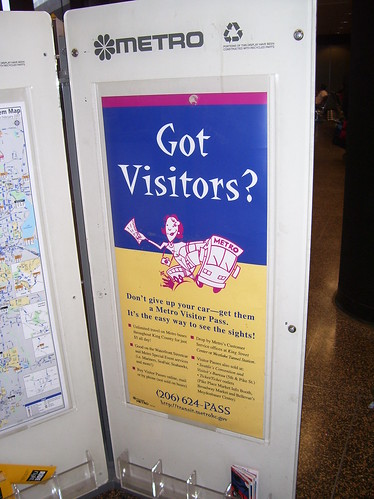
Right: King County, Washington Metro used to have a kiosk in the airport terminal promoting bus transit use. Now that they have a light rail station at the airport, they seem to have removed marketing materials from within the airport terminal.
Airports and transit
Transit wayfinding needs to be improved at all the airports, especially to be able to reach people who are less accustomed to riding transit, and therefore need more information in order to be comfortable in choosing it.
That's discussed here, "More on airport-related transit/transit for visitors."
Comprehensive airports planning at the regional scale would address public transit issues as well. It's really a surprise (not) that this isn't done.
A key element of appealing to international visitors is a reasonably efficient transit system for getting to the major lodging centers in the metropolitan area. This will improve for Dulles Airport with the extension of Silver Line service there sometime within the next 5-6 years.
Transit service to BWI Airport is pretty good, considering the distance from DC and has improved as BWI improved its surface transportation programming, integrated bus service to and from the train station into its ground transportation system, and MARC added weekend train service on the Penn Line. Light rail service to the airport is available from Baltimore, and WMATA runs a bus from the end of the Green Line Metro at Greenbelt--although this ride is now so expensive it's cheaper to take a MARC train.
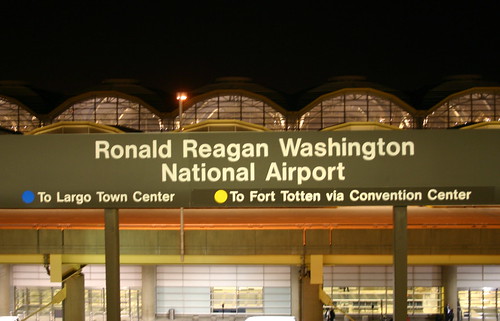 Left: Flickr photo by Elvert Barnes.
Left: Flickr photo by Elvert Barnes.National Airport has great transit service when the Metrorail is running--the subway station is conveniently located for reaching both terminals--and paltry service when the subway isn't running and airplanes are still landing and taking off.
Conclusion
DC needs to truly up its game as far as visitability, cultural tourism, and visitors centers are concerned.
National Tourism Week, World Tourism Day and other tourism promotion activities are a way to call attention to the need for better tourism planning, development, and management activities in DC.
Labels: cultural heritage/tourism, strategic communications and marketing, travel planning/tourism





16 Comments:
Put a smartrip machine at Dulles, because the bus driver on the 5a doesn't make change. And make sure it takes credit cards.
At least when I lived in Rosslyn, the 5a was very much used by international travelers.
At some point, the bikeshare stations couldn't validate out of country credit cards either. I think that was fixed. Understand it was an early bug.
You'd be surprised on how much the DC Flyer (I think that is the MWAA Magazine they distribute at airports is used). Granted that is lessening.
Biggest thing is meals. If you can a family to spend $100 more on food in DC you've got $10 in taxes.
... I should have explained why DC tax on food is so high, as you indicate there is an add'l meals tax on top of sales tax, like what Fairfax County wanted to do, because of the idea that many of these meals are purchased either by tourists or non-resident workers.
That, hotel room taxes, and the car rental taxes (but I don't think the parking tax) comprise the tourism tax revenue stream. Taxes on Verizon tickets go to improvements there. (FWIW, if PG didn't have a separate ticket tax, they'd likely make very little revenue from the Redskins Stadium.)
In my airport writings I do mention the need to add Fare machines to Dulles and BWI, although eventually that 5A and B30 bus will be eliminated.
But at least at Dulles other transit agencies serve it, and it would be nice to have a machine in the airport, not just at the coming Metrorail station.
Good point about DC Flyer magazine, and airline magazines, and Where magazine too. That might be something for next year...
for you...
https://metropolitanhistory.wordpress.com/2017/05/11/trumpism-and-the-suburbs/#more-1140
thanks, interesting take.
I personally don't buy it that affluent white suburbs turned out in much higher numbers for Clinton because there were "uncomfortable" with the racism on the surface.
Josh Barro has a better explanation, that those voters liked Clinton because of the signaling she was giving on various globalist positive enterprises. I mean, who there has an American car. It is BMW and lexus country..
Was talking to a friend at the DNC and she was not all shocked - for a variety of reasons Clinton is highly offensive to midwestern values. I mean, she is a cubs and white sox and yankee fan?
No need to rehash that stuff here, though.
In terms of cities, pretty clear that D party is in trouble without heavy black turnout. It was down to normal levels and that also turned the tide.
Well, I am weird in believing that a social justice message can have relevance. But we sure don't seem to be communicating it very well.
Your point about heavy black turnout it is important. It impacted the Maryland governor's race too. It's a static demographic though, so the long term implications are stark.
But overall the general anti-government narrative that prevails in discourse and politics doesn't help. I don't see that changing.
I mean how is it possible to make out that putting environmental restrictions on releasing coal ash in water or methane gas from oil wells and other sources is "bad."
That's a clear indication that there is something terribly wrong with the discourse.
It's not helped by television (and Internet) media supplanting print, as tv, even "news," is about "entertainment" not knowledge.
And messaging. E.g. health care. In a "gig economy" world, where businesses no longer provide "benefits," the govt. needs to step in an enable a basic set of supports.
====
the weird thing about HRC is that she is supposed to be a warm, great person in-person. That never comes across in her public personae.
... there was a line about Phil Gramm, that most politicians are nice in public and assholes in private, but he was an a* in public. HRC isn't an a* in public, she comes off as very competent, but she sure isn't warm.
But there was other stuff too. I thought it would be "easy" for the Dems to do attack ads on Trump and how he screwed business owners and put people out of work.
I saw one ad, done by unions, featuring an owner of a small business in Atlantic City that got stiffed, and it was awful, not succinct, too roundabout.
... but the chaos we see in the presidency now was obviously predictable and predicted, given the chaos of his business career and practices. This a.m. I was thinking about the "Pigpen" character from Peanuts.
Or George Steinbrenner
or Dan Snyder. I am definitely not interested in professional football, but I find fascinating the cases of teams like the Redskins under Snyder or even the Detroit Lions under the Fords or the current era Cleveland Browns, and systematic and systemic failure.
The Redskins are a zoo, but the Lions aren't, but fail equally. I think Cleveland does some zoo-ish things.
Then you have teams that have it together, across sports, like the Cleveland Indians, Theo Epstein's body of work, etc.
.... just like how the Brits have held off allowing Murdochs to buy the rest of Sky Channel, because of unethical behavior on the part of other media properties they own, to my way of thinking, the Redskins are run so poorly, why would DC want to give them hundreds of millions of dollars for a stadium? We need to be more diligent in "choosing" our "private partners" within "public"-private partnerships.
cf., again, the mistake GSA made wrt the Old Post Office building. Given his track record with bankruptcies and stiffing contractors and challenging tax assessments, those are all good reasons to deny a bid.
Or San Antonio (for sport dynasties).
Goes back to an old subject of yours -- system thinking. McK thinking here -- if you want to analyze a system look at payments and incentives.
DC would not do very well is a system analysis of political leadership. One decent mayor 40+ years of home rule and that was an accident.
In terms of trump/HRC, systems would suggest our primary is very broken and it is the role of money in politics that is driving that open. Trump even with 25% support was able to last in a primary b/c his other opponents had so much money they did not need to concede.*
Been reading Fragile by Design on banking systems crisis and that is the same conclusion (why some systems are designed to fail).
* contrast Virginia, which since George Allen had a string a decent governors (Gilmore was an exception, McDonnell was not as bad as people say the corruption thing aside). Very much related to the party system in VA.
http://bigthink.com/strange-maps/some-very-curious-maps-of-london.amp
... thinking about this more, "the" problem is complicated. It's about incentives sure. But the deeper problem is that rules based systems aren't very flexible in the face of crisis, or in general, to changes in circumstances (exogenous or endogenous conditions).
Plus, our political (and other types of systems aren't set up to be able to be "fully defined" by rules. There has to be room to act when things are more fuzzy.
But for this to work, you have to have a sense of honor, a commitment to the system, and maintaining it.
That's out the window with winner take all political and economic processes and systems. And a move to an entertainment-based media system. And a removal of strictures on "capital" in terms of being able to make unlimited political donations. Etc.
... e.g., my point that WMATA had equilibrium, could be somewhat half-assed and things worked (not the signals, but everything else), but adding the Silver Line broke the equilibrium, and stressed the system extranormally.
Having a Republican Party that repudiates government, the Citizens United ruling, the way that gerrymandering favors rural interests and puts into place a pretty unyielding Congress, subprime mortgages (it wasn't that people stretched the truth "a little," the people in the industry were incentivized to make mortgages without consequences for failures, as they got paid when the loan was executed; that got further strengthened by CBMS, and then by people taking out loans that they had way of ever paying--otoh, I can cut people a little slack when they took out a loan a little too big, figuring the economy would keep growing and prices would keep escalating, but many people took out loans that were impossible for them to pay, etc.) etc., has pushed the system into overdrive, constant oscillation.
... I mean, I don't know if you ever read science fiction, like Asimov's _Foundation_ series? We're like what happened there, the Mule wasn't planned for, came from the Second Foundation, and wasn't bound by rules, had the means to extranormally shape political and social forces.
We're like that now. People unwilling to be bound by honor (the "base", people like Sean Hannity, Trump, etc.) can't be stopped because "the design" of the system isn't resilient enough to be able to deal with it.
like with the United Airlines thing. It's rich when Congress holds a hearing on that, when they set up the system to produce that kind of outcome through deregulation (some, a lot of it was needed), mergers, and the removal of countervailing rules, regulations, and regulators to protect the public in the face of oligopoly.
one of the best lines in the movie "Hannah and Her Sisters" was the artist boyfriend of the sister Lee.
He recounted watching a PBS show on the Holocaust, and said "when they asked 'why did this happen?' they are asking the wrong question. They should be asking 'why doesn't this happen more often?'"
Was talking with Shyam Kannam about stuff after a presentation he made (brilliant, but still haven't written about it) and we talked about the Silver Line stressing the system. He said they can figure out why at Rosslyn the situation of reliability gets out of control because of the merging of the three lines, but can't figure out why the same thing doesn't happen at the other end (Stadium-Armory).
Or Uber. Uber is like a classic example of capital seizing all the "surplus value of labor."
I always had problems with the theory, because it gave little acknowledgement that the organizer of the assembly line deserved some credit for creating a system that created surplus value, that the value wasn't created by the act of work as much as the act of organization.
Ford might have kept "most" of the value, but he also raised wages significantly (but at the same time creating systems to keep workers and their social lives under observation).
Now we have a system where capital seizes most of the surplus value. And the political systems and neoliberalism reduce checks on capital, remove requirements to share some of the gains.
IT and telecommunications enables the organization of a slack resources (cars and people) into a system that can compete with taxis. But it isn't set up to be fair. Virtually all of the "surplus value" is captured by the organizer, Uber, with crumbs mostly for the drivers, abetted by venture capital subsidized fares to drive out the existing firms.
====
Does the average CEO really "deserve" compensation of $100MM or more/year? Mostly, they didn't build the system that produces those gains, they just sit at the top of it.
This is the big question of our times.
personally I blame free movement of capital, but that is just me and I don't have much theoretical grasp of why. Basically something to do with the dollar floating and inability to store value.
Just finished another book on the statistical takeover of science and I suspect it has something to do with that as well. The map is not the territory.
I agree "incentives" are not the right answer either -- I was pointing out they are the consultants way of approaching the problem. Incentives are a play but the problem is bigger.
always we are way off topic now and just throwing at the walls. The point of the london book was that the big things filter down into the structure and maps of the city.
haven't entered the cite yet... will do so later today.
wrt the off topic discussion, I've been thinking lately that I need to re-read _Political Parties_, which dates to around 1914. It's a classic book in political science, outlining among other things, what he termed "the iron law of oligarchy," how over time, wanting power overcomes organizational strictures and the interests of the mass.
Sure, there is the Growth Machine, the military-industrial complex, etc., but they didn't use to grab every possible $ and lever of control (despite all the fiction movies and books).
It's different now. There was a fiction book in the 1970s that I read, called _The R Document_, about an experiment of political oppression and control (semi relevant is _7 Days in May_ too), by the DOJ, in a company town in Arizona or someplace like that, a mining town. We're moving that way in real life now.
https://en.wikipedia.org/wiki/The_R_Document
... just read the description.
Post a Comment
<< Home